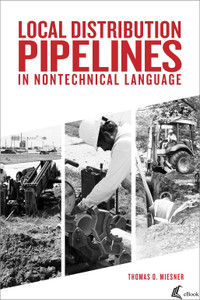Description
An introduction to managing threats to pipeline safety and operations, this new book examines all the types of threats – from illegal tapping to corrosion, cracking, accidental third-party damage, geotechnical hazards and defective construction – and explains the methods and practices used to prevent or mitigate them.
This book is an introduction to managing threats in pipelines. Everyone working in the pipeline industry – and anyone concerned with safe and reliable operation of pipelines – needs to be aware of threats and must understand how the resulting risks are managed.
A novel feature of the book is embedded QR codes and links with which the reader can access an extensive online library of reference documents, illustrations, photographs and videos.
The book opens with an introductory overview and a chapter on ‘Pipeline Engineering Principles,’ which introduces the reader to the infrastructure that transports our energy around the world: crude oil and natural gas pipelines. It also gives basic principles in pipeline engineering and explains some pipeline design concepts.
Pipelines are made using steel tubes called ‘line pipe,’ and Chapter 3, ‘Line Pipe Principles,’ covers the manufacture of this line pipe and the standards used to ensure high quality. Chapter 4, an ‘Introduction to In-line inspection, or ILI – the use of inspection tools inside a pipeline – reviews the in-line inspection tools available today for inspecting all the types of high-pressure pipelines.
Chapters 5 through 12 cover some of the main threats to pipelines: corrosion, cracking, mechanical damage, geohazards, material and construction defects, theft, and specific threats to submarine pipelines. Chapter 13, ‘Pipeline Defect Assessment Basics,’ introduces the reader to methods for assessing the significance of pipeline defects such as corrosion and dents.
Chapter 14 is devoted to ‘Pipeline Integrity Management.’ Integrity management is part of asset management and includes the many and varied activities pipeline operators must undertake to ensure that releases of products from their pipelines do not occur.
In the final chapter several eminent figures in the pipeline industry share their thoughts on the state of current technology and the needs and promise of the future.
Features & Benefits
- Introduces all major pipeline threats and the strategies used to manage and mitigate them
- Combines essential engineering principles with practical safety applications across the pipeline lifecycle
- Includes QR codes and links to an extensive online library of videos, visuals, and reference materials
- Covers both onshore and offshore (submarine) pipeline risks with dedicated chapters on ILI, defects, and theft
- Features expert insights on current technologies and future needs in pipeline integrity management
Audience
- Pipeline engineers and maintenance personnel
- Pipeline integrity and safety professionals
- Asset managers and risk mitigation teams
- New entrants and students in pipeline engineering or energy infrastructure
- Regulators and consultants working in pipeline safety and compliance
About the Authors
John Tiratsoo was editor of the Pipelines International Digest. Before starting Pipelines International Digest, John was the editor GPM and of the independent UK-based magazine Pipeline World, the successor to Pipes & Pipelines International, for over 20 years. Prior to this, he achieved chartered (professional) status as a civil engineer and spent his early career building roads and bridges in the UK for the Department of Transport. He then moved to join Sir Alexander Gibb and Partners in East Africa, where he spend a year in Tanzania building roads, two years based in Nairobi on a variety of projects, and two years in the bush in Malawi as an engineer on a major water-treatment and pipeline project for Blantyre.
Having returned to the UK and unpacked, he joined Scientific Surveys Ltd, publisher of Pipes & Pipelines International, in 1979. Since then he has become an active member of the Pipeline Industries Guild, sitting on its committees, its Council, and now its Board (as an ex-officio member). Part of his work with the Guild involves editing and publishing its journal, and the annual Pipeline Industry Directory, its directory of members.
Details
Type: eBook
Pages: 470
Published: 2015
ISBN: 9780990670063-ebook






